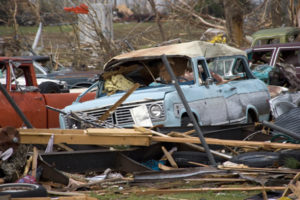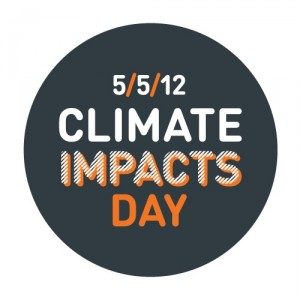Tornadoes keep striking the Midwest like so many hammers pounding away at one nail after another.

Just looking at the pictures of the devastation makes me shudder. I can’t imagine how terrifying it must have been to live through it, or how discouraging it must be for those who are sifting through the rubble for their personal belongings and wondering where they’re going to sleep, let alone live.
They’re also facing an important and not necessarily clear decision. Should they rebuild? And if so, how?
Ironically, these were exactly the same questions being debated in St. Louis at the Sustainable Disaster Recovery Conference 
Both Greensburg and Joplin have made bold and inspiring commitments to rebuild their communities to be as sustainable as possible. In convening the Sustainable Disaster Recovery Conference with SLU, organizers hoped to raise awareness about the role sustainability can play in disaster response and recovery wherever the need arises. They put a particular focus on pre-disaster planning, emergency response, long-term recovery, and community resilience.
The question of resilience came up over and over again during the two-day conference, as different speakers articulated what resilience means to them and their communities. The definition that clarified the concept for me was simply this:
Resilience is the ability to adapt to changing conditions and withstand and rapidly recover from disruptions due to emergencies.
Experts from the U.S. Environmental Protection Agency, the Federal Emergency Management Agency, the American Association of Planners, and the U.S. Department of Housing and Urban Development all stressed how much advance planning increases resilience and recovery. Specifically, pre-planning helps in two important ways. First, it lessons the damage and injury a disaster will do. Second, it empowers communities and individuals to take charge of the recovery process, helping to reduce the sense of despair and hopelessness that might otherwise set in while speeding recovery and reducing the cost of rebuilding, should individuals, businesses and communities decide to do so.
Daniel Wallach, the Founder and Executive Director of Greensburg GreenTown and GreenTown Joplin (pictured here on the left with Steve Hewitt, the former Greensburg City Administrator), noted that the most essential question citizens, elected officials, and business leaders must ask following any disaster is:
“What kind of community do we want after a disaster destroys the one we know?”
Coalitions of citizens, government institutions, and community organizations in Greensburg and Joplin have resoundingly answered that question by becoming shining examples of “green” rebuilding post-disaster. They’ve also shown that being able to successfully turn a vision of resilience into a reality is a challenge that requires the cooperation of local, state and federal agencies as well as the engagement of citizens who represent all sectors of society.
Added Steve Hewitt, as terrible as a disaster is, it creates “a blank canvas” and “a perfect opportunity” to create the kind of community we want for ourselves and our kids. He remains enthusiastic about rebuilding green because “it’s smart…a total no brainer! Rebuilding green creates jobs, promotes health, is fiscally responsible, practical, and creates new opportunities.”
Noted David Webb, Program Manager for the Center for Sustainability and the coordinator of the Conference, “Natural disasters of all kinds are showing signs of increased frequency and intensity, a recurring phenomenon that some scientists have referred to as “serial weather.” The consequences are devastating to be sure but, like phoenixes rising from the ashes, towns and communities all over our nation and the world at large are emerging stronger and more resilient in the wake of devastating tragedies.
“Sustainable disaster recovery weaves the principles of sustainability into the systemic process of planning for, responding to, and recovering from (short- and long-term) natural disasters. In other words, sustainable disaster recovery,” concluded Webb, “is about planning and (re)constructing stronger, livable communities that are as efficient as they are resilient. It’s never too early to start thinking about what to do when the “unthinkable” happens.”
FOR MORE INFORMATION
To learn more about how communities can rebuild sustainably after natural disasters, please see the following:
Greensburg GreenTown is a nonprofit organization established to help the people of Greensburg, Kansas rebuild as a model “green” community following the devastating tornado in May of 2007. The town has made a remarkable comeback, reinventing itself as a showcase for sustainable building and green living now recognized around the world. GreenTown works to make green building and living easily understood, appealing and accessible to all.

About the St. Louis University Center for Sustainability
Building on the Jesuit tradition of leadership and service, Saint Louis University’s Center for Sustainability uses interdisciplinary research, education, and development to advance sustainable approaches to the world’s social, economic and environmental challenges. The Center develops partnerships across businesses, government agencies, communities, and academic institutions that steward Earth’s resources to help build socially responsible, environmentally conscious, and economically prosperous communities.














2 thoughts on “Tornadoes Highlight Need for Sustainable Disaster Recovery”
With relatives living right near the epicenter in Washington, IL, the devastation looks 10 times worse in person. My Uncle’s home was completely destroyed and I’m taking a week off work to help him out.
James, I hope your relatives have been able to figure out how to rebuild or relocate in a way that is not too costly or too painful. They are lucky to have you there helping them.
Comments are closed.